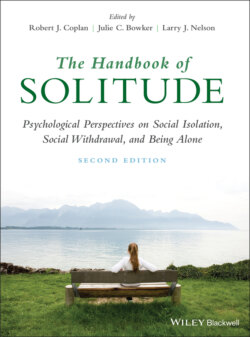Читать книгу The Handbook of Solitude - Группа авторов - Страница 12
Alone Again: Revisiting Psychological Perspectives on Solitude
ОглавлениеThe experience of solitude is a ubiquitous phenomenon. Over the course of the life span, humans experience solitude for many different reasons and subjectively respond to solitude with a wide range of reactions and consequences. Some people may retreat to solitude as a respite from the stresses of life, for quiet contemplation, to foster creative impulses, or to commune with nature. Others may suffer the pain and loneliness of social isolation, withdrawing or being forcefully excluded from social interactions.
These exemplars illustrate the complex nature of solitude and its relation to well‐being – and speak to what has been deemed the paradox of solitude. Indeed, theorists and researchers haver highlighted several different paradoxical aspects of solitude over the years, including: (1) despite the widely held beliefs that solitude serves self‐enhancing functions, it is often experienced as unwelcome and painful; (2) time alone can serve as both a reward (“me time”) and a punishment (time outs, solitary confinement); (3) solitude is viewed as both normative as well as a cause and consequence of psychopathology; (4) time alone can both interfere with and improve our relationships with others; and, as we will discuss in some detail herein; (5) solitude can simultaneously confer both costs and benefits for our well‐being (Coplan et al., 2018; Galanaki, 2015; Merton, 1958; Larson, 1999).
It should also be noted that there is little consensus among researchers as to how solitude should be conceptualized, operationalized, and assessed. For example, some perspectives emphasize physical separation from others, although in some cases this becomes operationalized in varied ways. For example, participants might be required simply to sit and think away from others (Wilson et al., 2014), whereas in other studies the focus is on activities while participants are physically alone (Leary et al., 2003). Of note, there is really no agreed‐upon physical “distance” from others that is mandated in order for an individual to be considered alone. Other perspectives focus on perceived separation from others (Larson, 1990). In this regard, participants might report feeling alone and lonely even in the presence of others (van Roekel et al., 2015). Coplan and Bowker (2017) described this conceptual distinction as solitude representing a state of mind rather than a state of being. Finally, as we will discuss later, contemporary technology now makes it possible (and common) for us to be physically alone but in the virtual presence of – and interacting with – many others (Hollis et al., 2020).
These different conceptualizations of solitude highlight the many different “faces” of solitude. In 2014, the Handbook of Solitude was the first academic volume to specifically focus on the diverse theoretical and empirical approaches to the psychological study of solitude. Since that time, there has been considerable advancement in our understanding of solitude, with novel and exciting research focusing on previously unconsidered aspects of being alone. In this second edition of the Handbook, we are absolutely thrilled to present a blend of new and updated chapters that approach the study of solitude from a myriad of theoretical perspectives and methodological approaches, and with critically important applications for practice and policy.
In this introductory chapter, we revisit some of the critical historical components of the study of solitude, consider some of the novel issues that have emerged in recent years, and describe a broad theoretical model of the causes and consequences of solitude. We finish the chapter with an overview of the novel and updated contents of this new volume.
